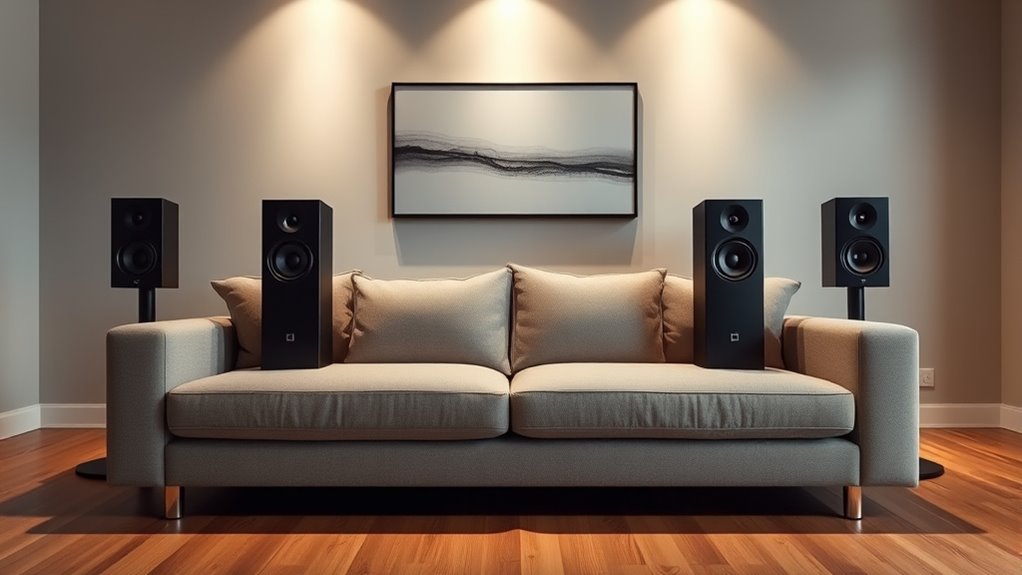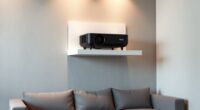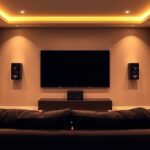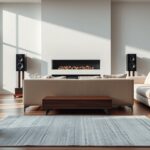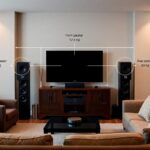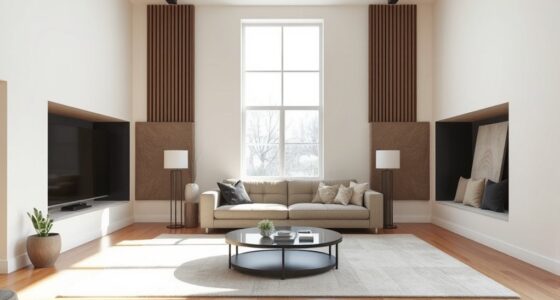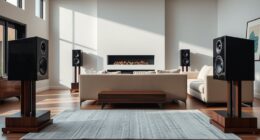Creating an equilateral triangle with your speakers and listening position guarantees sound reaches your ears evenly, delivering clear, balanced audio. This setup minimizes echoes and phase issues, resulting in improved soundstage and imaging. Proper placement also helps your room’s acoustics work in your favor, reducing reflections and dead spots. Getting this right makes a noticeable difference in sound quality. Keep exploring how adjusting your setup can make your listening experience even better.
Key Takeaways
- Proper placement ensures sound waves reach your ears simultaneously, enhancing clarity and stereo imaging.
- Creating an equilateral triangle positions speakers evenly around the listener, reducing phase issues.
- Correct placement minimizes reflections and echoes caused by room acoustics.
- Maintaining consistent distances helps achieve balanced soundstage and better audio immersion.
- Regularly reassessing speaker angles and positions optimizes sound quality over time.

Proper speaker placement can make a significant difference in your audio experience. When you set up your speakers correctly, you’re optimizing how sound interacts with your room acoustics, leading to clearer, more balanced audio. One of the most effective methods to achieve this is by creating an equilateral triangle between your speakers and your listening position. This setup helps ensure that sound waves reach your ears simultaneously and with proper balance, which is essential for an immersive listening experience.
Start by positioning your speakers so that each one is equidistant from your main listening spot. Imagine an invisible equilateral triangle with you at the center and the speakers at each corner. This means measuring carefully to keep the distances consistent. When you do this, you’re reducing the chances of sound reflections and phase issues that can muddle the audio clarity. Proper speaker placement directly influences how your room acoustics impact sound quality; in rooms with reflective surfaces or irregular shapes, the wrong positioning can cause echoes or dead spots. Adjusting the placement helps manage these acoustics, improving the overall soundstage and imaging. Additionally, considering the room’s acoustic characteristics can further enhance sound quality and clarity.
Once your speakers are roughly positioned, it’s time to contemplate speaker calibration. Calibration involves fine-tuning the system to compensate for room acoustics and speaker characteristics. Many modern receivers have auto-calibration tools, but you can also do this manually with a sound level meter or calibration microphone. The goal is to balance the sound levels and optimize frequency response so that each speaker produces a cohesive soundscape. Proper calibration ensures that the audio you hear is accurate, regardless of room imperfections. It’s not just about placing the speakers; it’s about making sure they work harmoniously within your space.
Another critical aspect is angling your speakers toward your listening position. Even if they are correctly placed in an equilateral triangle, slight adjustments in their tilt can improve high-frequency response and stereo imaging. Remember, the goal is to make your speakers vanish into the soundstage, creating a seamless experience that feels natural and immersive. Regularly revisit your setup and calibration, especially if you notice changes in room furniture or layout, because room acoustics can shift over time, affecting sound quality.
Frequently Asked Questions
How Does Room Shape Affect Speaker Placement?
Room shape greatly influences your speaker placement because it affects room acoustics and sound reflection. Irregular or oddly shaped rooms can cause uneven sound distribution, so you should position your speakers to minimize reflections and dead spots. Consider furniture placement too, as it can absorb or diffuse sound. By adjusting your speakers within the room’s shape, you optimize sound quality and create a balanced listening environment tailored to your space.
Can Speaker Placement Improve Sound Quality in Small Rooms?
You can definitely boost sound quality in small rooms by optimizing speaker placement. Think of it as hitting two birds with one stone—adjust your speakers to form an equilateral triangle with your listening position, and use acoustic treatment to reduce echo. Additionally, furniture arrangement plays a key role; keep large pieces away from speakers to prevent sound reflections. Small tweaks like these can turn your space into a sound haven.
What Are Common Mistakes When Placing Speakers?
You often make mistakes in speaker placement by ignoring proper speaker height and wiring configuration. Placing speakers too high or low can distort sound, while poor wiring setup causes imbalance and interference. Make certain your speakers are at ear level when seated and follow a consistent wiring configuration for ideal sound. Avoid placing speakers too close to walls or corners, which can cause sound reflections and muddy clarity. Proper placement enhances your listening experience considerably.
How Do Different Speaker Types Influence Placement?
Different speaker types influence your placement considerations because each has unique sound dispersion and power needs. For instance, bookshelf speakers should be placed closer to walls for fuller sound, while floor-standing speakers need more space to breathe. Center channels require direct alignment with your TV, and surround speakers should be positioned to create an immersive experience. Adjust placement accordingly to optimize sound quality based on your specific speaker type.
Is Speaker Placement Different for Outdoor Versus Indoor Setups?
Yes, speaker placement differs for outdoor versus indoor setups. Outdoor acoustics are more affected by open space, so you should position speakers carefully to avoid sound dispersion and echo. Focus on ideal speaker positioning by elevating them and aiming toward your listening area. For indoor setups, you have more control over acoustics, but outdoor environments require adjusting placement to manage reflections, background noise, and sound projection effectively.
Conclusion
Proper speaker placement transforms your listening experience. Imagine hosting a movie night where every sound feels immersive—thanks to positioning your speakers in an equilateral triangle, you feel like you’re right there in the action. Just like Sarah, who upgraded her setup and finally enjoyed crystal-clear sound during family movie nights, you too can create a space where every note and whisper comes alive. Start with the right placement, and watch your audio world elevate to new heights.
